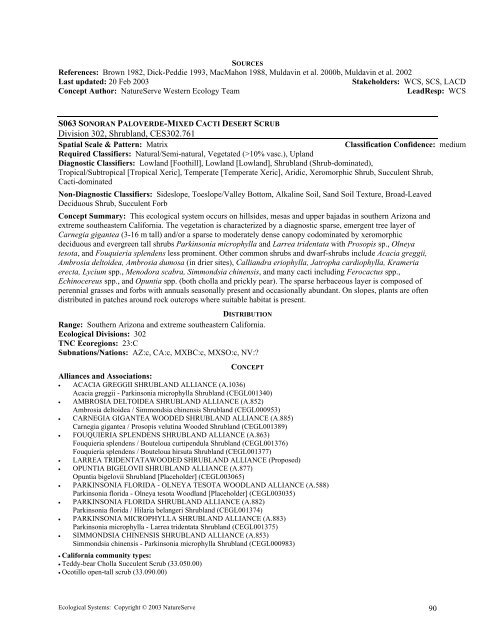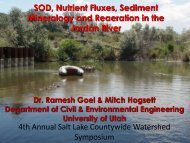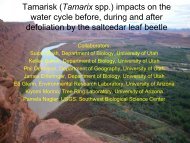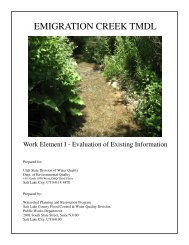SOURCESReferences: Brown 1982, Dick-Peddie 1993, MacMahon 1988, Muldavin et al. 2000b, Muldavin et al. 2002Last updated: 20 Feb 2003Stakeholders: WCS, SCS, LACDConcept Author: NatureServe Western Ecology TeamLeadResp: WCSS063 SONORAN PALOVERDE-MIXED CACTI DESERT SCRUBDivision 302, Shrubland, CES302.761Spatial Scale & Pattern: MatrixClassification Confidence: mediumRequired Classifiers: Natural/Semi-natural, Vegetated (>10% vasc.), UplandDiagnostic Classifiers: Lowland [Foothill], Lowland [Lowland], Shrubland (Shrub-dominated),Tropical/Subtropical [Tropical Xeric], Temperate [Temperate Xeric], Aridic, Xeromorphic Shrub, Succulent Shrub,Cacti-dominatedNon-Diagnostic Classifiers: Sideslope, Toeslope/Valley Bottom, Alkaline Soil, Sand Soil Texture, Broad-LeavedDeciduous Shrub, Succulent ForbConcept Summary: This ecological system occurs on hillsides, mesas and upper bajadas in sou<strong>the</strong>rn Arizona andextreme sou<strong>the</strong>astern Cali<strong>for</strong>nia. The vegetation is characterized by a diagnostic sparse, emergent tree layer ofCarnegia gigantea (3-16 m tall) and/or a sparse to moderately dense canopy codominated by xeromorphicdeciduous and evergreen tall shrubs Parkinsonia microphylla and Larrea tridentata with Prosopis sp., Olneyatesota, and Fouquieria splendens less prominent. O<strong>the</strong>r common shrubs and dwarf-shrubs include Acacia greggii,Ambrosia deltoidea, Ambrosia dumosa (in drier sites), Calliandra eriophylla, Jatropha cardiophylla, Krameriaerecta, Lycium spp., Menodora scabra, Simmondsia chinensis, and many cacti including Ferocactus spp.,Echinocereus spp., and Opuntia spp. (both cholla and prickly pear). The sparse herbaceous layer is composed ofperennial grasses and <strong>for</strong>bs with annuals seasonally present and occasionally abundant. On slopes, plants are oftendistributed in patches around rock outcrops where suitable habitat is present.DISTRIBUTIONRange: Sou<strong>the</strong>rn Arizona and extreme sou<strong>the</strong>astern Cali<strong>for</strong>nia.Ecological Divisions: 302TNC Ecoregions: 23:CSubnations/Nations: AZ:c, CA:c, MXBC:c, MXSO:c, NV:?CONCEPTAlliances and Associations:• ACACIA GREGGII SHRUBLAND ALLIANCE (A.1036)Acacia greggii - Parkinsonia microphylla Shrubland (CEGL001340)• AMBROSIA DELTOIDEA SHRUBLAND ALLIANCE (A.852)Ambrosia deltoidea / Simmondsia chinensis Shrubland (CEGL000953)• CARNEGIA GIGANTEA WOODED SHRUBLAND ALLIANCE (A.885)Carnegia gigantea / Prosopis velutina Wooded Shrubland (CEGL001389)• FOUQUIERIA SPLENDENS SHRUBLAND ALLIANCE (A.863)Fouquieria splendens / Bouteloua curtipendula Shrubland (CEGL001376)Fouquieria splendens / Bouteloua hirsuta Shrubland (CEGL001377)• LARREA TRIDENTATAWOODED SHRUBLAND ALLIANCE (Proposed)• OPUNTIA BIGELOVII SHRUBLAND ALLIANCE (A.877)Opuntia bigelovii Shrubland [Placeholder] (CEGL003065)• PARKINSONIA FLORIDA - OLNEYA TESOTA WOODLAND ALLIANCE (A.588)Parkinsonia florida - Olneya tesota Woodland [Placeholder] (CEGL003035)• PARKINSONIA FLORIDA SHRUBLAND ALLIANCE (A.882)Parkinsonia florida / Hilaria belangeri Shrubland (CEGL001374)• PARKINSONIA MICROPHYLLA SHRUBLAND ALLIANCE (A.883)Parkinsonia microphylla - Larrea tridentata Shrubland (CEGL001375)• SIMMONDSIA CHINENSIS SHRUBLAND ALLIANCE (A.853)Simmondsia chinensis - Parkinsonia microphylla Shrubland (CEGL000983)• Cali<strong>for</strong>nia community types:• Teddy-bear Cholla Succulent Scrub (33.050.00)• Ocotillo open-tall scrub (33.090.00)Ecological Systems: Copyright © 2003 NatureServe 90
• All-thorn Tall Scrub Unique Stands (33.100.00)• Crucifixion-thorn Tall Scrub Unique Stands (33.110.00)• Elephant Tree Unique Stands (33.120.00)• Brittlebush - White Bursage Dwarf Scrub (33.130.00)• Foothill Palo Verde - Saguaro Tall Scrub (33.150.00)• Sonoran Mixed Woody and Succulent Scrub (33.210.00)SOURCESReferences: Bowers and McLaughlin 1987, Brown 1982, MacMahon 1988, McAuliffe 1993, Niering and Lowe1984, Robichaux 1999, Shreve and Wiggins 1964Last updated: 20 Feb 2003Stakeholders: WCSConcept Author: NatureServe Western Ecology TeamLeadResp: WCSS065 INTER-MOUNTAIN BASINS MIXED SALT DESERT SCRUBDivision 304, Shrubland, CES304.784Spatial Scale & Pattern: Large PatchClassification Confidence: mediumRequired Classifiers: Natural/Semi-natural, Vegetated (>10% vasc.), UplandDiagnostic Classifiers: Lowland [Lowland], Shrubland (Shrub-dominated), Alluvial flat, Alluvial plain, Plain,Alkaline Soil, Saline Substrate Chemistry, Calcareous, Silt Soil Texture, Clay Soil Texture, Xeromorphic Shrub,Dwarf-Shrub, Atriplex spp.Non-Diagnostic Classifiers: Basin floor, Temperate [Temperate Continental], Oligotrophic SoilConcept Summary: This extensive ecological system includes open-canopied shrublands of typically saline basins,alluvial slopes and plains across <strong>the</strong> Intermountain western U.S. This type also extends in limited distribution into<strong>the</strong> sou<strong>the</strong>rn Great Plains. Substrates are often saline and calcareous, medium- to fine-textured, alkaline soils, butinclude some coarser-textured soils. The vegetation is characterized by a typically open to moderately denseshrubland composed of one or more Atriplex species such as Atriplex confertifolia, Atriplex canescens, Atriplexpolycarpa, or Atriplex spinifera. O<strong>the</strong>r shrubs present to codominate may include Artemisia tridentata ssp.wyomingensis, Chrysothamnus viscidiflorus, Ericameria nauseosa, Ephedra nevadensis, Grayia spinosa,Krascheninnikovia lanata, Lycium spp., Picrothamnus desertorum, or Tetradymia spp. Sarcobatus vermiculatus isgenerally absent, but if present does not codominate. The herbaceous layer varies from sparse to moderately denseand is dominated by perennial graminoids such as Achna<strong>the</strong>rum hymenoides, Bouteloua gracilis, Elymus lanceolatusssp. lanceolatus, Pascopyrum smithii, Pleuraphis jamesii, Pleuraphis rigida, Poa secunda, or Sporobolus airoides.Various <strong>for</strong>bs are also present.DISTRIBUTIONRange: Intermountain western U.S., extending in limited distribution into <strong>the</strong> sou<strong>the</strong>rn Great Plains.Ecological Divisions: 303, 304, 306TNC Ecoregions: 10:C, 11:C, 18:C, 19:C, 20:C, 21:C, 26:C, 27:C, 28:C, 4:?, 6:C, 8:?, 9:CSubnations/Nations: AZ:c, CA:c, CO:c, ID:c, MT:c, NM:c, NV:c, OR:c, UT:c, WA:c, WY:cCONCEPTAlliances and Associations:• ATRIPLEX (LENTIFORMIS, POLYCARPA) SHRUBLAND ALLIANCE (A.864)Atriplex (lenti<strong>for</strong>mis, polycarpa) Shrubland [Placeholder] (CEGL003016)• ATRIPLEX CANESCENS SHRUBLAND ALLIANCE (A.869)Atriplex canescens - Artemisia tridentata Shrubland (CEGL001282)Atriplex canescens - Ephedra viridis Shrubland (CEGL001287)Atriplex canescens - Krascheninnikovia lanata Shrubland (CEGL001285)Atriplex canescens / Achna<strong>the</strong>rum hymenoides Shrubland (CEGL001289)Atriplex canescens / Bouteloua gracilis Shrubland (CEGL001283)Atriplex canescens / Calycoseris parryi Shrubland (CEGL001284)Atriplex canescens / Par<strong>the</strong>nium confertum Shrubland (CEGL001290)Atriplex canescens / Pleuraphis jamesii Shrubland (CEGL001288)Atriplex canescens / Purshia stansburiana Shrubland (CEGL001286)Atriplex canescens / Sporobolus airoides Shrubland (CEGL001291)Atriplex canescens / Sporobolus wrightii Shrubland (CEGL001292)Atriplex canescens Shrubland (CEGL001281)Ecological Systems: Copyright © 2003 NatureServe 91
- Page 1:
LANDCOVER DESCRIPTIONSFORTHE SOUTHW
- Page 6 and 7:
D02—RECENTLY BURNEDSource: SWReGA
- Page 8 and 9:
DISTRIBUTIONRange: Restricted to th
- Page 11 and 12:
• PINUS FLEXILIS WOODLAND ALLIANC
- Page 13 and 14:
S009 INTER-MOUNTAIN BASINS CLIFF AN
- Page 15 and 16:
and conglomerates in the limestone
- Page 17 and 18:
filifolia, Artemisia tridentata ssp
- Page 19 and 20:
SOURCESReferences: Barbour and Bill
- Page 21 and 22:
Distichlis spicata - Lepidium perfo
- Page 23 and 24:
• California community types:•
- Page 25 and 26:
S020 NORTH AMERICAN WARM DESERT WAS
- Page 27 and 28:
• Catclaw Acacia - Blue Sage (33.
- Page 29 and 30:
CONCEPTAlliances and Associations:
- Page 31 and 32:
Populus tremuloides / Symphoricarpo
- Page 33 and 34:
S025 ROCKY MOUNTAIN SUBALPINE-MONTA
- Page 35 and 36:
• California community types:•
- Page 37 and 38:
Abies lasiocarpa / Saxifraga bronch
- Page 39 and 40: CONCEPTAlliances and Associations:
- Page 41 and 42: Pinus contorta / Juniperus communis
- Page 43 and 44: Pseudotsuga menziesii / Physocarpus
- Page 45 and 46: CONCEPT• California community typ
- Page 47 and 48: Picea pungens / Betula occidentalis
- Page 49 and 50: 500 m in British Columbia to 2800 m
- Page 51 and 52: Establishment is erratic and believ
- Page 53 and 54: Non-Diagnostic Classifiers: Forest
- Page 55 and 56: Juniperus osteosperma, pure or near
- Page 57 and 58: DISTRIBUTIONRange: Sierra Madre Occ
- Page 59 and 60: • JUNIPERUS DEPPEANA WOODLAND ALL
- Page 61 and 62: SOURCESReferences: Barbour and Bill
- Page 63 and 64: • Jeffrey Pine / Sadler Oak / Bea
- Page 65 and 66: S042 INTER-MOUNTAIN WEST ASPEN-MIXE
- Page 67 and 68: in wet areas Salix scouleriana. Whe
- Page 69 and 70: Salix planifolia / Carex scopulorum
- Page 71 and 72: DISTRIBUTIONRange: Occurs in the mo
- Page 73 and 74: • ARTEMISIA NOVA SHRUB HERBACEOUS
- Page 75 and 76: Concept Summary: This ecological sy
- Page 77 and 78: • CEANOTHUS GREGGII - FREMONTODEN
- Page 79 and 80: SOURCESReferences: Barbour and Bill
- Page 81 and 82: Diagnostic Classifiers: Montane [Lo
- Page 83 and 84: egion to the west, and the Edwards
- Page 85 and 86: Dynamics: Fire does not appear to p
- Page 87 and 88: • Creosote Bush - Brittlebush - O
- Page 89: Non-Diagnostic Classifiers: Toeslop
- Page 93 and 94: This is typically a system of extre
- Page 95 and 96: •SOURCESReferences: Bowers 1982,
- Page 97 and 98: S070 SONORA-MOJAVE MIXED SALT DESER
- Page 99 and 100: • Shrub Live Oak Scrub (71.095.00
- Page 101 and 102: Concept Summary: This ecological sy
- Page 103 and 104: • EPHEDRA VIRIDIS SHRUBLAND ALLIA
- Page 105 and 106: • ARTEMISIA CANA (SSP. BOLANDERI,
- Page 107 and 108: mature (>150 years old) juniper tre
- Page 109 and 110: • BOUTELOUA ERIOPODA HERBACEOUS A
- Page 111 and 112: Artemisia tridentata ssp. tridentat
- Page 113 and 114: • SPHAEROMERIA ARGENTEA HERBACEOU
- Page 115 and 116: DISTRIBUTIONRange: Occurs above upp
- Page 117 and 118: CONCEPTAlliances and Associations:
- Page 119 and 120: • PASCOPYRUM SMITHII HERBACEOUS A
- Page 121 and 122: not always significantly contribute
- Page 123 and 124: decrease the fuel load and thus the
- Page 125 and 126: within this system in the southern
- Page 127 and 128: • BOUTELOUA HIRSUTA HERBACEOUS AL
- Page 129 and 130: that is deposited there from upland
- Page 131 and 132: • JUNIPERUS MONOSPERMA WOODLAND A
- Page 133 and 134: NLCD Woody Wetland TypesAreas where
- Page 135 and 136: Salix drummondiana / Mesic Forbs Sh
- Page 137 and 138: Picea engelmannii / Carex angustata
- Page 139 and 140: Pinus ponderosa / Crataegus douglas
- Page 141 and 142:
CONCEPTAlliances and Associations:
- Page 143 and 144:
CONCEPTAlliances and Associations:
- Page 145 and 146:
Environment: This system is found p
- Page 147 and 148:
TNC Ecoregions: 17:C, 22:C, 23:C, 2
- Page 149 and 150:
• PROSOPIS (GLANDULOSA, VELUTINA)
- Page 151 and 152:
This SW Regional GAP Landcover Type
- Page 153 and 154:
Dynamics: Periodic and intermediate
- Page 155 and 156:
• DISTICHLIS SPICATA INTERMITTENT
- Page 157 and 158:
Caltha leptosepala - Rhodiola rhoda
- Page 159 and 160:
• PHIPPSIA ALGIDA SATURATED HERBA
- Page 161 and 162:
S105 MEDITERRANEAN CALIFORNIA SUBAL
- Page 163 and 164:
Dynamics: Hydrology processes prima
- Page 165 and 166:
Blaisdell, J. P., and R. C. Holmgre
- Page 167 and 168:
Day, T. A., and R. G. Wright. 1985.
- Page 169 and 170:
Hoffman, G. R., and R. R. Alexander
- Page 171 and 172:
Larson, M., and W. H. Moir. 1987. F
- Page 173 and 174:
Muldavin, E., P. Durkin, M. Bradley
- Page 175 and 176:
Rogers, C. M. 1950. The vegetation
- Page 177 and 178:
Walford, G. M. 1996. Statewide clas
- Page 179:
Ecological Systems: Copyright © 20





